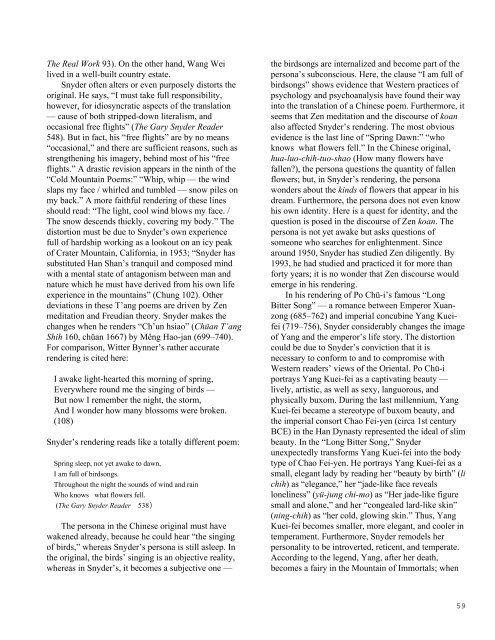their - The University of Texas at Dallas
their - The University of Texas at Dallas
their - The University of Texas at Dallas
You also want an ePaper? Increase the reach of your titles
YUMPU automatically turns print PDFs into web optimized ePapers that Google loves.
<strong>The</strong> Real Work 93). On the other hand, Wang Wei<br />
lived in a well-built country est<strong>at</strong>e.<br />
Snyder <strong>of</strong>ten alters or even purposely distorts the<br />
original. He says, “I must take full responsibility,<br />
however, for idiosyncr<strong>at</strong>ic aspects <strong>of</strong> the transl<strong>at</strong>ion<br />
— cause <strong>of</strong> both stripped-down literalism, and<br />
occasional free flights” (<strong>The</strong> Gary Snyder Reader<br />
548). But in fact, his “free flights” are by no means<br />
“occasional,” and there are sufficient reasons, such as<br />
strengthening his imagery, behind most <strong>of</strong> his “free<br />
flights.” A drastic revision appears in the ninth <strong>of</strong> the<br />
“Cold Mountain Poems:” “Whip, whip — the wind<br />
slaps my face / whirled and tumbled — snow piles on<br />
my back.” A more faithful rendering <strong>of</strong> these lines<br />
should read: “<strong>The</strong> light, cool wind blows my face. /<br />
<strong>The</strong> snow descends thickly, covering my body.” <strong>The</strong><br />
distortion must be due to Snyder’s own experience<br />
full <strong>of</strong> hardship working as a lookout on an icy peak<br />
<strong>of</strong> Cr<strong>at</strong>er Mountain, California, in 1953; “Snyder has<br />
substituted Han Shan’s tranquil and composed mind<br />
with a mental st<strong>at</strong>e <strong>of</strong> antagonism between man and<br />
n<strong>at</strong>ure which he must have derived from his own life<br />
experience in the mountains” (Chung 102). Other<br />
devi<strong>at</strong>ions in these T’ang poems are driven by Zen<br />
medit<strong>at</strong>ion and Freudian theory. Snyder makes the<br />
changes when he renders “Ch’un hsiao” (Chüan T’ang<br />
Shih 160, chüan 1667) by Mêng Hao-jan (699–740).<br />
For comparison, Witter Bynner’s r<strong>at</strong>her accur<strong>at</strong>e<br />
rendering is cited here:<br />
I awake light-hearted this morning <strong>of</strong> spring,<br />
Everywhere round me the singing <strong>of</strong> birds —<br />
But now I remember the night, the storm,<br />
And I wonder how many blossoms were broken.<br />
(108)<br />
Snyder’s rendering reads like a totally different poem:<br />
Spring sleep, not yet awake to dawn,<br />
I am full <strong>of</strong> birdsongs.<br />
Throughout the night the sounds <strong>of</strong> wind and rain<br />
Who knows wh<strong>at</strong> flowers fell.<br />
(<strong>The</strong> Gary Snyder Reader 538)<br />
<strong>The</strong> persona in the Chinese original must have<br />
wakened already, because he could hear “the singing<br />
<strong>of</strong> birds,” whereas Snyder’s persona is still asleep. In<br />
the original, the birds’ singing is an objective reality,<br />
whereas in Snyder’s, it becomes a subjective one —<br />
the birdsongs are internalized and become part <strong>of</strong> the<br />
persona’s subconscious. Here, the clause “I am full <strong>of</strong><br />
birdsongs” shows evidence th<strong>at</strong> Western practices <strong>of</strong><br />
psychology and psychoanalysis have found <strong>their</strong> way<br />
into the transl<strong>at</strong>ion <strong>of</strong> a Chinese poem. Furthermore, it<br />
seems th<strong>at</strong> Zen medit<strong>at</strong>ion and the discourse <strong>of</strong> koan<br />
also affected Snyder’s rendering. <strong>The</strong> most obvious<br />
evidence is the last line <strong>of</strong> “Spring Dawn:” “who<br />
knows wh<strong>at</strong> flowers fell.” In the Chinese original,<br />
hua-luo-chih-tuo-shao (How many flowers have<br />
fallen), the persona questions the quantity <strong>of</strong> fallen<br />
flowers; but, in Snyder’s rendering, the persona<br />
wonders about the kinds <strong>of</strong> flowers th<strong>at</strong> appear in his<br />
dream. Furthermore, the persona does not even know<br />
his own identity. Here is a quest for identity, and the<br />
question is posed in the discourse <strong>of</strong> Zen koan. <strong>The</strong><br />
persona is not yet awake but asks questions <strong>of</strong><br />
someone who searches for enlightenment. Since<br />
around 1950, Snyder has studied Zen diligently. By<br />
1993, he had studied and practiced it for more than<br />
forty years; it is no wonder th<strong>at</strong> Zen discourse would<br />
emerge in his rendering.<br />
In his rendering <strong>of</strong> Po Chü-i’s famous “Long<br />
Bitter Song” — a romance between Emperor Xuanzong<br />
(685–762) and imperial concubine Yang Kueifei<br />
(719–756), Snyder considerably changes the image<br />
<strong>of</strong> Yang and the emperor’s life story. <strong>The</strong> distortion<br />
could be due to Snyder’s conviction th<strong>at</strong> it is<br />
necessary to conform to and to compromise with<br />
Western readers’ views <strong>of</strong> the Oriental. Po Chü-i<br />
portrays Yang Kuei-fei as a captiv<strong>at</strong>ing beauty —<br />
lively, artistic, as well as sexy, languorous, and<br />
physically buxom. During the last millennium, Yang<br />
Kuei-fei became a stereotype <strong>of</strong> buxom beauty, and<br />
the imperial consort Chao Fei-yen (circa 1st century<br />
BCE) in the Han Dynasty represented the ideal <strong>of</strong> slim<br />
beauty. In the “Long Bitter Song,” Snyder<br />
unexpectedly transforms Yang Kuei-fei into the body<br />
type <strong>of</strong> Chao Fei-yen. He portrays Yang Kuei-fei as a<br />
small, elegant lady by reading her “beauty by birth” (li<br />
chih) as “elegance,” her “jade-like face reveals<br />
loneliness” (yü-jung chi-mo) as “Her jade-like figure<br />
small and alone,” and her “congealed lard-like skin”<br />
(ning-chih) as “her cold, glowing skin.” Thus, Yang<br />
Kuei-fei becomes smaller, more elegant, and cooler in<br />
temperament. Furthermore, Snyder remodels her<br />
personality to be introverted, reticent, and temper<strong>at</strong>e.<br />
According to the legend, Yang, after her de<strong>at</strong>h,<br />
becomes a fairy in the Mountain <strong>of</strong> Immortals; when<br />
59

















